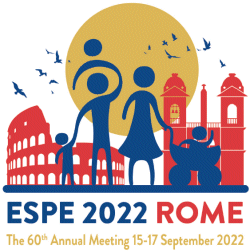
60th Annual ESPE (ESPE 2022)
Rome,
Italy
15 Sep 2022 - 17 Sep 2022
Rapid Free Communications
Growth and Syndromes
hrp0095rfc7.1 | Growth and Syndromes | ESPE2022
The grandma X-rays-independent height prediction
German Alina , Albertsson-Wikland Kerstin , Shmoish Michael , Rubin Lisa , Niklasson Aimon , Hochberg Ze'ev
hrp0095rfc7.2 | Growth and Syndromes | ESPE2022
Once-Weekly Somapacitan vs Daily GH in Children with GH Deficiency: The Randomized Phase 3 REAL 4 Trial
Miller Bradley , Blair Joanne , Højby Michael , Böttcher Volker , Juul Kildemoes Rasmus , Maniatis Aristides , Beck Bang Rikke , Mori Jun , Polak Michel , Stagi Stefano , Horikawa Reiko
hrp0095rfc7.3 | Growth and Syndromes | ESPE2022
Genetic analysis of children with clinically non-syndromic tall stature
Adamovicova Katerina , Plachy Lukas , Dusatkova Petra , Lebl Jan , Maratova Klara , Sumnik Zdenek , Neuman Vit , Petruzelkova Lenka , Snajderova Marta , Obermannova Barbora , Kolouskova Stanislava , Malikova Jana , Pruhova Stepanka
hrp0095rfc7.4 | Growth and Syndromes | ESPE2022
Efficacy and safety of bilateral epiphysiodesis in extremely tall adolescents
Aeppli Tim , Benyi Emelie , Wehtje Henrik , Sävendahl Lars
hrp0095rfc7.5 | Growth and Syndromes | ESPE2022
A relevant cellular model to study imprinting disorders: dental pulp stem cells
Giabicani Eloïse , Pham Aurélie , Sélénou Céline , Sobrier Marie-Laure , Linglart Agnès , Poliard Anne , Chaussain Catherine , Netchine Irène
hrp0095rfc7.6 | Growth and Syndromes | ESPE2022
Hormone Replacement Therapy After Pubertal Induction in Adolescents and Young Adults with Turner Syndrome: A Survey Study
Dowlut-McElroy Tazim , Kanakatti Shankar Roopa



